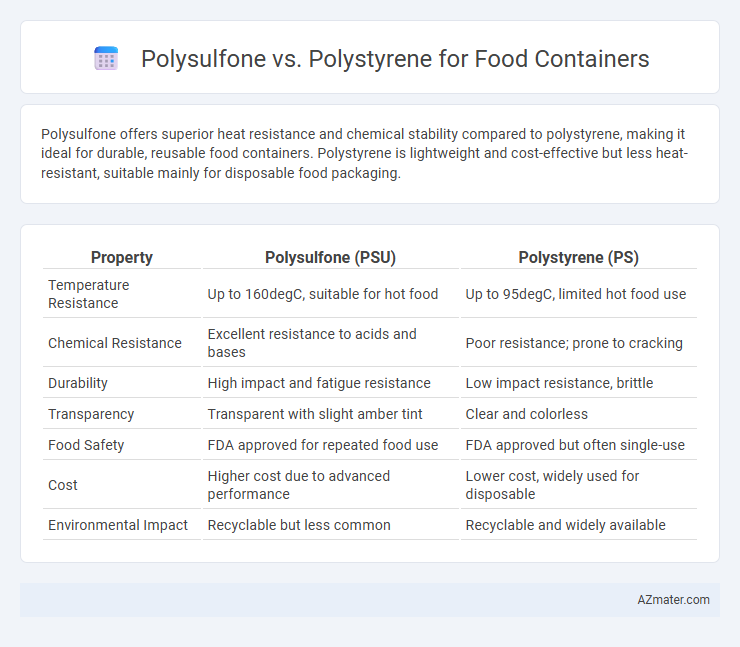Polysulfone offers superior heat resistance and chemical stability compared to polystyrene, making it ideal for durable, reusable food containers. Polystyrene is lightweight and cost-effective but less heat-resistant, suitable mainly for disposable food packaging.
Table of Comparison
| Property | Polysulfone (PSU) | Polystyrene (PS) |
|---|---|---|
| Temperature Resistance | Up to 160degC, suitable for hot food | Up to 95degC, limited hot food use |
| Chemical Resistance | Excellent resistance to acids and bases | Poor resistance; prone to cracking |
| Durability | High impact and fatigue resistance | Low impact resistance, brittle |
| Transparency | Transparent with slight amber tint | Clear and colorless |
| Food Safety | FDA approved for repeated food use | FDA approved but often single-use |
| Cost | Higher cost due to advanced performance | Lower cost, widely used for disposable |
| Environmental Impact | Recyclable but less common | Recyclable and widely available |
Introduction to Food Container Materials
Polysulfone (PSU) and polystyrene (PS) are widely used materials in food container manufacturing, each offering distinct properties tailored for food safety and durability. Polysulfone is valued for its high thermal stability, chemical resistance, and ability to withstand repeated sterilization, making it ideal for microwave and dishwasher-safe containers. Polystyrene, meanwhile, is favored for its rigidity, clarity, and cost-effectiveness but is less heat-resistant and prone to brittleness under stress, limiting its use in high-temperature food applications.
Overview of Polysulfone
Polysulfone (PSU) is a high-performance thermoplastic known for its exceptional heat resistance, mechanical strength, and chemical stability, making it ideal for durable food containers. Unlike polystyrene, polysulfone maintains structural integrity at high temperatures, resists hydrolysis, and withstands repeated sterilization processes commonly required in food storage and preparation. These properties ensure polysulfone containers provide superior longevity and safety compared to conventional polystyrene options.
Overview of Polystyrene
Polystyrene is a lightweight, rigid plastic commonly used for disposable food containers due to its low cost and excellent insulation properties. It offers good clarity and moisture resistance but has limited heat resistance and may leach styrene, raising food safety concerns. Its widespread use in single-use packaging must be balanced with environmental impact considerations since it is not easily biodegradable.
Thermal Stability Comparison
Polysulfone exhibits superior thermal stability compared to polystyrene, maintaining its structural integrity at temperatures up to 150degC, whereas polystyrene typically deforms around 70-100degC. This high thermal resistance makes polysulfone ideal for food containers requiring repeated heating or sterilization processes. Polystyrene's lower glass transition temperature limits its use to cold or room temperature applications, reducing its suitability for microwave or dishwasher exposure.
Chemical Resistance Differences
Polysulfone exhibits superior chemical resistance compared to polystyrene, making it more suitable for food containers exposed to harsh cleaning agents or acidic and alkaline substances. Polysulfone maintains its structural integrity and resists degradation when in contact with detergents, alcohols, and oils, whereas polystyrene is prone to chemical stress, resulting in brittleness and potential leaching. This enhanced chemical durability ensures polysulfone food containers offer safer, longer-lasting performance in demanding food storage and processing environments.
Food Safety and Health Impacts
Polysulfone offers superior food safety compared to polystyrene due to its high thermal stability and resistance to chemical leaching, making it suitable for repeated use and hot food storage. Polystyrene, often containing styrene monomers, poses health risks through potential migration of toxic substances, especially when exposed to heat or acidic foods. Choosing polysulfone containers minimizes exposure to harmful chemicals, ensuring safer food storage and reduced health risks related to plastic contamination.
Environmental Impact and Sustainability
Polysulfone offers superior durability and thermal resistance compared to polystyrene, reducing waste through extended product life and recyclability options. Polystyrene, often single-use and non-biodegradable, contributes significantly to plastic pollution and poses challenges in recycling due to its lightweight and brittle nature. Emphasizing sustainable packaging, polysulfone's potential for repeated use and lower environmental footprint makes it a more eco-friendly choice for food containers.
Durability and Reusability Factors
Polysulfone demonstrates superior durability over polystyrene in food containers due to its high thermal stability and resistance to chemical degradation, allowing it to withstand frequent washing and high-temperature sterilization processes without compromising integrity. Polystyrene, while cost-effective and lightweight, tends to be more brittle and prone to cracking or warping under repeated use and exposure to heat. The reusability of polysulfone containers significantly outperforms polystyrene, making them a preferred choice for long-term food storage and sustainable applications.
Cost Effectiveness and Market Availability
Polysulfone offers higher heat resistance and durability compared to polystyrene, making it more cost-effective for repeated food container use despite a higher initial price. Polystyrene is widely available and inexpensive, ideal for single-use or disposable containers, but its lower thermal tolerance limits reusability. Market availability favors polystyrene due to mass production, while polysulfone is more niche, targeting premium or industrial applications.
Conclusion: Choosing the Right Material
Polysulfone offers superior heat resistance, durability, and chemical stability, making it ideal for repeated use and high-temperature food storage compared to polystyrene. Polystyrene, being lightweight and cost-effective, suits single-use or cold food containers but lacks the robustness required for long-term or microwave applications. Selecting the right material depends on the specific use case, balancing factors like temperature tolerance, durability, safety, and cost efficiency.

Infographic: Polysulfone vs Polystyrene for Food Container
 azmater.com
azmater.com